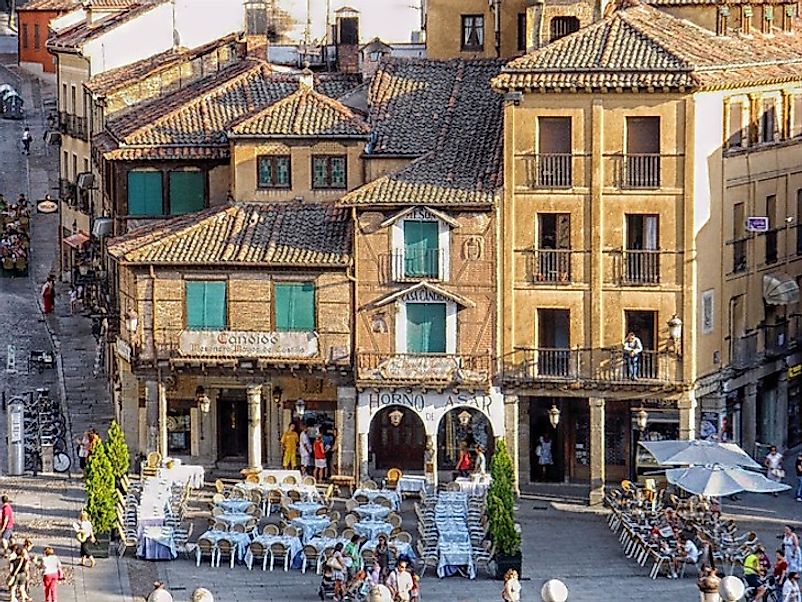The People Of Spain: Cultures Of The World

5. Description
The people of Spain live in a country encompassing 85 percent of the Iberian Peninsula, itself lying on the southwestern tip of Europe. The Atlantic Ocean, the Pyrenees Mountains, the Strait of Gibraltar, the Mediterranean Sea, and Portugal form its boundaries. For thousands of years, the Iberian Peninsula has been occupied by diverse cultures, which have each imparted their own various customs and social influences upon the Spanish people. With the invading Phoenicians, Carthaginians, Romans, and Visigoths (Germanic tribes) of ancient times, and the Arab and Berber invaders as well as the Moors from Northern Africa in the Middle Ages all leaving their marks, Spain has always been a land of diversity. This is especially evident in the country's languages and many dialects. Castilian Spanish is the official language of the nation. However, Catalan-Valencian, Basque, Galician and Occitan (Aranese) serve as "co-official" languages as well.
4. Architecture
With the diversity of the Spanish terrain including coastal, interior, mountainous, lowland, and plateau regions alike, manmade constructions come just as varied themselves. Distinct forms of Spanish architecture can be found all across the country, both within large urban centers and the sparsely populated agrarian areas and the rural towns, villages, and hamlets that dot them. Roman monuments, such as the Aqueduct in Segovia and the Tri-Gated Arch at Medinaceli, still leave their marks on the Spanish landscape. Islamic architecture, including the Alhambra in Granada and the Great Mosque in Cordoba, as well as gothic cathedrals, castles, and mansions, all add to the architectural diversity. The sturdy, one-meter-thick-walled rustic homes that cluster together in villages and towns in rural areas reflect the local geography and geology themselves. In Spain, as in most industrialized European countries, there exists a complementary mix of modern and aged architecture. However, unique to Spain is the distinctive architectural designs of Anton Gaudi and his Sagrada Familia, which can be found in Barcelona. This site is considered iconic of the most remarkable minor basilicas, and is one of the most frequented sites in all of Spain.
3. Cuisine
The Spanish diet is entrenched for the most part in the agrarian nature of its traditional society. Therein, a range of bread, legumes, rice, garden vegetables, cured pork, lamb, veal, beef, eggs, cheese, chicken, rabbit and squab make up the staples of a well-stocked Spanish pantry. The Spanish national dishes, of which many are known internationally, are often heavily seasoned with paprika and saffron. Included within the most notable national fare are cocidos (regional stews), tapas, paella, stuffed peppers, tortilla Espaňola (an omelet made with potatoes and eggs), as well as the famous Serrano mountain hams. A typical Spanish day will begin with a light breakfast, often consisting of coffee or hot chocolate, as well as bread of some sort. The main meal usually eaten at home, is called the "comida". Taken at midday around 2:00 p.m., most business hours are planned around taking a break for the time of comida. There is a light snack ("merienda"or "tapas") between 6 and 8 p.m., which often replaces the light meal ("cena") of soup, eggs, fish, or cold meats taken at around 10 p.m. At all times, however, the taking of nourishment is a celebratory experience.
2. Cultural Significance
Much like the diversity of its terrain, cuisine and languages, the contributions to the fine arts by the Spanish are varied, and enormously significant the world over. Considered to be one of the earliest and most influential novels of all time is Miguel de Cervantes’s Don Quixote. Meanwhile, the poetry of Federico Garcia Lorca is world-renowned itself, as have been the works of the five Spanish Nobel laureates in Literature. Visual arts have been buoyed with the works of artists such as El Greco, Diego de Velazquez, Francisco de Goya, Joan Miro, Salvador Dali, Juan Gris, and Pablo Picasso. Performing arts include the song, dance, and guitar of the Flamenco. Notably, the Spanish guitar was invented in Andalusia in the late 1700s, when a 6th string was added to the Moorish lute. Its modern shape was first seen in the 1870s. Classical guitarists Joaquin Rodrigo and Andres Segovia are internationally known musicians, as is Placido Domingo, known for his tenor voice and operatic gifts. Spanish people love sports, especially football (soccer), basketball, volleyball, and endurance cycling. And, lest we forget, the Corridas de toros, the bullfights, list among the greatest sports stars in the country as well. What began as an ancient religious ceremony has evolved into the popular, yet bloody, spectacle that it is seen today.
1. Threats
Beyond the typical issues that plague all modern societies, such as assimilation to globalized norms and "generational" conflicts between different age groups, there is no direct threat to the Spanish people, per se. However, inner turmoil regarding the independence movements of the Catalonians and the Basque have continued to surface and resurface for years. Spain is a heterogenous land of many cultures and kingdoms, but over the years some of the minority languages and cultures of Spain, particularly in Catalonia and Basque, have been greatly repressed. Both the Basques and the Catalonians have members among them who wish to fight for secession and independence from the Spanish national government. Demonstrations continue in Catalonia, and at times aggressiveness, and even violence, erupt from the most extreme Basque rebels.











